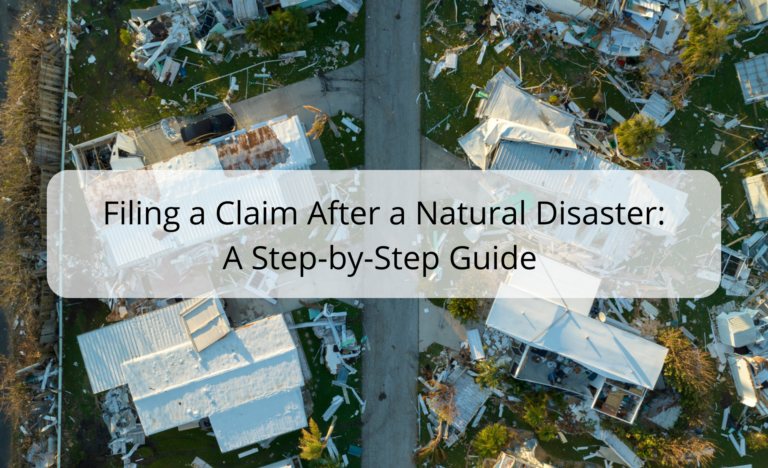Natural disasters are unpredictable, and the aftermath can be overwhelming for property owners. If your property has been impacted by a flood, hurricane, tornado, or other disaster, knowing how to file an insurance claim effectively is key to a smooth recovery. This step-by-step guide will walk you through the essential actions to take after a disaster and provide insights to ensure your claim is processed quickly and accurately.
Step 1: Ensure Safety First
Before beginning the claims process, ensure that you and anyone on the property are safe. Inspect for visible damage without putting yourself in harm’s way. For serious damage, such as structural instability or gas leaks, contact emergency services immediately.
Quick Tips:
– Avoid turning on power if the building is flooded or if there’s water around electrical outlets.
– Document any safety hazards with photos but only if it’s safe to do so.
Step 2: Notify Your Insurance Company
Once the immediate danger has passed, contact your insurance company to report the damage. Most insurers have a specific timeframe in which claims must be filed after a disaster, so prompt notification is essential. Explain the type and extent of the damage, and ask about your policy’s specific coverage for natural disasters.
Quick Tips:
– Have your policy number and personal information ready for a faster conversation.
– Ask your insurer if they require any specific documentation before you begin cleanup.
Step 3: Document the Damage Thoroughly
The documentation stage is one of the most important parts of the claims process. Take clear, detailed photos and videos of all damaged areas, including both interior and exterior sections of the property. Document every item that has been damaged and keep a written list of repairs that will be needed.
Quick Tips:
– Capture wide shots of each room as well as close-up shots of individual items or damages.
– Label and organize your documentation so you can quickly access it if needed by your insurer or adjuster.
Step 4: Prevent Further Damage
Most insurance policies require property owners to prevent additional damage after the initial incident. Once you’ve documented everything, take reasonable measures to protect your property from further harm. This might include boarding up broken windows, placing a tarp over a damaged roof, or removing standing water.
Quick Tips:
– Keep all receipts for any materials or services (like tarps or security) you use to protect your property, as these may be reimbursed by your insurance.
– Notify your insurance company of any urgent repairs you need to make right away.
Step 5: File Your Claim with Supporting Documents
When you file your claim, submit it with all of your documentation, including photos, videos, repair estimates, and a detailed inventory of damaged items. This ensures your claim is comprehensive and gives your insurer a complete picture of the damages.
Quick Tips:
– Ask your insurance company for an estimated timeline for claim processing.
– Save copies of all documentation submitted, including emails and claim forms, for future reference.
Step 6: Work with Your Insurance Adjuster
Once your claim is filed, the insurance company will typically assign an adjuster to assess the damage. You may also choose to hire a public adjuster who works specifically for you to ensure your claim is fairly valued and that no details are overlooked.
Quick Tips:
– Walk through your property with the adjuster and make sure they understand the full extent of the damage.
– Clarify any questions about coverage limits, exclusions, and next steps with the adjuster.
Efficient Communication with Your Insurer
– Be Clear and Concise: When speaking with your insurer, provide only relevant details about your claim to avoid unnecessary back-and-forth.
– Follow Up in Writing: After any phone call, follow up with an email summarizing the conversation. This creates a record of all communications.
– Document All Interactions: Keep a log of dates, names, and notes from each conversation you have with your insurance company. This can be helpful if there are delays or disputes.
Frequently Asked Questions
Q: What if my insurer isn’t responsive?
A: If your insurance company isn’t responding, start by escalating your concern within the company. Ask to speak with a supervisor and follow up in writing to document your attempts. You can also contact your state’s insurance department for assistance. Working with a public adjuster can also help, as they can often expedite the process and advocate on your behalf.
Q: Can I start repairs before the adjuster arrives?
A: It’s best to avoid major repairs until the adjuster has assessed the damage. However, you can make temporary fixes to prevent further damage. Be sure to document these repairs and keep all related receipts.
Q: Do I need a public adjuster if the insurance company provides one?
A: While the insurance company’s adjuster will assess your claim, a public adjuster works solely for you, helping maximize your settlement and ensuring a fair evaluation. Many property owners find a public adjuster helpful, especially for large or complex claims.
Moving Forward with Confidence
Filing an insurance claim after a natural disaster can be challenging, but following these steps can streamline the process and help ensure a fair settlement. For those looking for additional guidance, D.A. Lamont Public Adjusters is here to provide expert support every step of the way. Our team understands the complexities of disaster claims and works tirelessly to advocate for our clients, making sure you receive the compensation needed to recover fully.
If you need assistance navigating the insurance claims process, contact D.A. Lamont Public Adjusters today. We’re here to help you rebuild with confidence.


